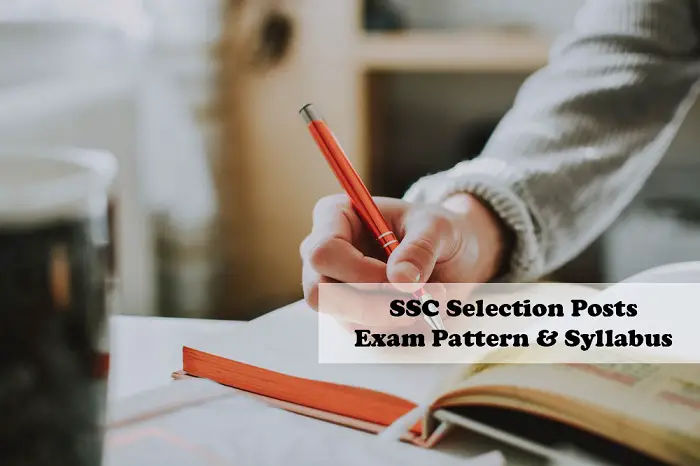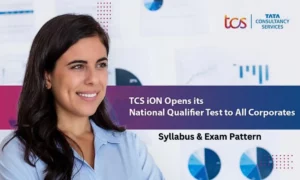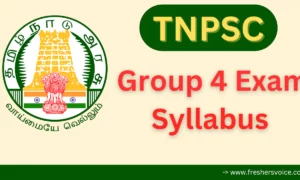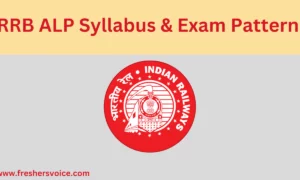The SSC Selection posts exam pattern & syllabus got released. As the exam nature of SSC is a bit competitive, applicants have to spend time learning each and every topic thoroughly to crack the examination. The syllabus to be covered for the examination is vast in nature. Candidates who start preparing early have a high chance of passing through the examination with decent marks. General questions and questions oriented to technical skills will be asked to check candidate’s overall capability for the post. Read below for the detailed syllabus and pattern for the SSC examination.

Current Opportunities at SSC:
SSC Exam notification for selection posts phase-XI was released on 06 March 2023. There are about 5,369 vacancies for selection posts. Candidates with any degree can apply for the job. Basic pay ranges from Rs. 5200-34800 per month. Those who have just finished their studies can also apply for SSC jobs. Candidates who are selected will be placed across India based on requirements. Applications will be available online from 06 March 2023. Click on the SSC Selection Posts 2023 to learn more details and apply. The last date to submit the application would be 27 March 2023.
SSC Exam Pattern 2023 for Selection Posts:
The candidate must go through a computer-based test followed by an interview. Candidates will be given 100 MCQs with a time duration of 1 hour to complete. A negative marking of 0.5 is there for each wrong answer. The questions can be broadly categorised into General knowledge & aptitude. Each question carries two marks. Hence, it’s a total of 100 questions with 200 marks.
| Subject | No. of Questions | Marks |
| General Intelligence | 25 | 50 |
| General Awareness | 25 | 50 |
| Quantitative Aptitude | 25 | 50 |
| English Language | 25 | 50 |
SSC Syllabus 2023
SSC has formulated the exam syllabus in such a way as to test the computer skills of the candidate as well as the general skills a person should possess to properly fit for the job for filtering efficient candidates among a pool of applications received. The break ups of the test with respect to matriculation, higher secondary as well as graduate and above level are as follows:
- Matriculation Level
General Intelligence: The type of questions would be nonverbal. Some of the topics of the test are space visualisation, problem-solving, analysis, judgement, decision-making, similarities & differences, number series ( arithmetical), non-verbal series, visual memory, discriminating observation, relationship concepts, figure classification, abstract dealings of ideas, symbols & their relationship, arithmetical computation and other analytical functions.
General Awareness: Questions on this topic are designed to test the awareness of candidates about the happenings around them. Questions will be of current events and details about India and its neighbouring nations, particularly in the fields of Culture, Geography, Sports, History, Economy and General Polity. These are general questions, and one doesn’t need any specific degree in that.
Quantitative Aptitude: Problems related to Number Systems, Fundamental arithmetical operations, Percentages, Computation of Whole Numbers, Decimals & Fractions and the relationship between Numbers, Discount, use of Tables and Graphs, Ratio and Proportion, Averages, Interest, Profit and Loss, Mensuration, Time and Distance, Ratio and Time, Time and Work will be asked as questions in this category.
English Language: Candidates are tested to have a general understanding of the English language, grammar, sentence structure, vocabulary, synonyms, antonyms & the correct usage of words in writing ability.
- Higher Secondary level
General Intelligence: Both verbal & non – verbal type questions are asked. Questions on topics such as Symbolic/Number Analogy, Trends, Figural Analogy, Space Orientation, Semantic Classification, Semantic Analogy, Symbolic operations, Punched hole/pattern-folding & unfolding, Semantic Series, Figural Pattern – folding and completion, Embedded figures, Figural Series, Venn Diagrams, Symbolic/Number Classification, Drawing inferences, Figural Classification, Problem Solving, Social Intelligence, Emotional Intelligence, Word Building, Coding and decoding, Number Series, Critical Thinking and some other subtopics such as numerical operations.
General Awareness: Questions on this topic are asked to check the candidate’s environmental and societal awareness. Current event questions in a scientific aspect will be asked. Some other questions would be related to our country’s neighbouring countries with respect to History, Geography, Culture, Economics, General politics & scientific research.
Quantitative Aptitude: Arithmetic, Number Systems, Computation of Whole Numbers, Decimal and Fractions, Relationship between numbers Fundamental arithmetical operations: 24 Averages, Interest (Simple and Compound), Percentages, Ratio and Proportion, Square roots, Profit and Loss, Discount, Partnership Business, Mixture and Alligation, Time and distance, Time and work. Algebra: Basic algebraic identities of School Algebra & Elementary surds and Graphs of Linear Equations. Geometry: Familiarity with elementary geometric figures & facts: Triangle and its various kinds of centres, Circle and its chords, tangents, Congruence and similarity of triangles, angles subtended by chords of a circle, common tangents to two/ more circles. Mensuration: Triangle, Quadrilaterals, Regular Polygons, Regular Right Pyramid with triangular or square, Circle, Right Circular Cylinder, Right Prism, Right Circular Cone, Sphere, Hemispheres, Rectangular Parallelepiped, Base Trigonometry: Trigonometry, Complementary angles, Trigonometric ratios, Height and distances (simple problems only) Standard Identities etc., Statistical Charts: Frequency polygon, Use of Tables and Graphs, Histogram, Bar-diagram, Pie Chart
English Language: Error spotting, One word substitution, Improvement of Sentences, Synonyms and Antonyms, Active/ Passive Voice of Verbs, Conversion into Direct/ Indirect narration, Fill in the Blanks, Spellings/ Detecting Mis-spelt words, Idioms & Phrases, Shuffling of Sentence in parts & passage, Cloze Passage, Comprehension Passage.
- Graduation & above level:
General Intelligence: Questions will be would include both verbal as well as non-verbal types. They comprise analogies, similarities and differences, space visualisation, spatial orientation, problem-solving, analysis, judgement, decision making, visual memory, arithmetical reasoning and figural classification, arithmetic number series, discrimination, observation, relationship concepts, statement conclusion, syllogistic reasoning, coding and decoding non-verbal series, etc. The topics are Semantic Analogy, Figural Analogy, Symbolic/Number Analogy, Semantic Classification, Figural Classification, Symbolic/ Number Classification, Semantic Series, Figural Series, Number Series, Problem Solving, Numerical Operations, symbolic Operations, Trends, Space Orientation, Word Building, Coding & decoding, Space Visualization, Venn Diagrams, Figural Pattern – folding and completion, Drawing inferences, Punched hole/ pattern – folding & unfolding, Indexing, coding, decoding and classification, Address, Small & Capital letters/ numbers Embedded Figures, Critical thinking, Date & city matching, Classification of centre codes/ roll numbers, Emotional Intelligence, Social Intelligence and any other areas.
General Awareness:
Questions are framed to check the awareness of candidates about the surroundings and environment. Some questions would be current events, and some would be questions related to India & its neighbouring countries regarding General Polity, Scientific Research, History, Culture, Geography and Economic Scene.
Quantitative Aptitude: Questions would be designed to assess the candidate’s use of numbers & number sense. The topics to cover are the computation of whole numbers, decimals, Percentages, Ratios & Proportions, Square roots, Averages, Interest, Profit and Loss, fractions and relationships between numbers, Discount, Partnership Business, Mixture and Allegation, Time and distance, Time & Work, Graphs of Linear Equations, Congruence and similarity of triangles, Triangle and its various kinds of centres, Basic algebraic identities of School Algebra & Elementary surds, tangents, Circle and its chords, common tangents to two or more circles, angles subtended by chords of a circle, Triangle, Quadrilaterals, Regular Polygons, Circle, Right Prism, Sphere, Hemispheres, Trigonometric ratio, Degree & Radian Measures, Standard Identities, Rectangular Parallelepiped, Right Circular Cone, Right Circular Cylinder, Regular Right Pyramid with triangular/ square base, Histogram, Frequency polygonComplementary angles, Heights and Distances, Bar diagram & Pie chart.
English Language: The candidates’ basic English comprehension and writing abilities will be tested.
Hence the SSC Selection posts exam pattern & syllabus! Give it a look and start preparing every topic without leaving anything behind to secure desired results. Before preparing for the examination, try to understand the exam pattern, syllabus, and other requirements. To know more about the examination and other details, Click Here and take a look!
Frequently Asked Questions(FAQs) of SSC Selection Posts Exam Pattern & Syllabus:
How many questions will be asked for SSC Selection post examination?
Candidates need to attend a total of 100 questions for the SSC Selection post-examination.
Is there negative marking for SSC Selection post examination?
Yes, a negative marking of 0.5 is there for each wrong answer.
What are the topics of SSC Exam Pattern?
Candidates will be asked questions on the following topics: General Intelligence, General Awareness, Quantitative Aptitude and English Language.
What is the duration of SSC Selection post examination?
The SSC Examination will be conducted for 1 hour.



